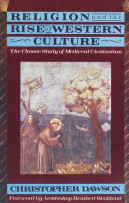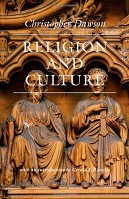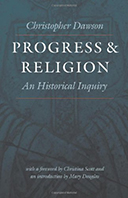 Religion and the Rise of Western Culture (1950) is the book compiled from the second series of Gifford Lectures delivered by Christopher Dawson at the University of Edinburgh between 1948 and 1949. With memories of the Second World War still fresh in people’s minds, the work highlights the striking relevance of a study of medieval culture. Speaking of the end of the Roman Empire and the onset of the Dark Ages he states: “We have learnt that barbarism is [still] an ugly underlying reality which may erupt with shattering force whenever the moral authority of a civilisation loses its control.” Consequently, he argues, “the history of the Dark Ages has acquired, or ought to acquire, a new significance.”
Religion and the Rise of Western Culture (1950) is the book compiled from the second series of Gifford Lectures delivered by Christopher Dawson at the University of Edinburgh between 1948 and 1949. With memories of the Second World War still fresh in people’s minds, the work highlights the striking relevance of a study of medieval culture. Speaking of the end of the Roman Empire and the onset of the Dark Ages he states: “We have learnt that barbarism is [still] an ugly underlying reality which may erupt with shattering force whenever the moral authority of a civilisation loses its control.” Consequently, he argues, “the history of the Dark Ages has acquired, or ought to acquire, a new significance.”
Central Themes
Following on from the first series (compiled in book form under the title Religion and Culture), which expressed the theme that religion is the dynamic element in all cultures, he now takes a detailed look at Western culture in particular and examines the effects of the Christian religion on the history of the West since the beginning of the Christian era.
In his wide-ranging introduction, which contains some truly original insights, he sets out what is probably the underlying theme of the whole book: that the “energy of spiritual unrest” of Western culture is a side effect of the worldview of the Christian religion and its missionary spirit – “a spirit that strives to incorporate itself in humanity and to change the world.”
Rejecting the monochrome view of medieval culture as a morass of superstition and barbarism, he asserts that despite its evident failings on many levels, it was “the matrix in which the Western type was formed and the ultimate source of the new forces that have moved and transformed the world.”
The chapters of the book cover all the major themes of medieval life, from monasteries to the papacy, from chivalry and courtly love to the influence of the barbarians on the development of Christianity and vice versa. Above all he traces the source of the dynamic element in Christian culture to the tension between “two social traditions and two spiritual worlds – the war society of the barbarian kingdom with its cult of heroism and aggression and the peace society of the Christian Church with its ideals of asceticism and renunciation…”
Evaluation of the Work
Whatever topic Dawson is dealing with, he manages to make what at first sight seems a merely erudite study something highly relevant for his times – and perhaps also for our own. His insights, such as his thesis of the origins of courtly love in the high culture of Muslim Spain, still ring true today, as does his rescuing of the medieval culture from the one-dimensional stereotypes of the past.
PRAISE FOR THE ORIGINAL EDITION:
“This book […] is a survey in a single volume of the rise and decline of mediaeval Christendom, and is one of the most noteworthy books produced in this generation about the mediaeval world […] These processes are analysed with a sympathy, a judgement and a use of the original material that make this short book of quite exceptional value.” – Walter Oakeshott, The Spectator, April 7, 1950


